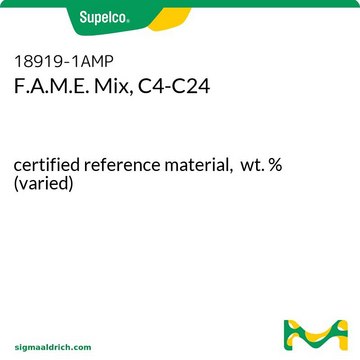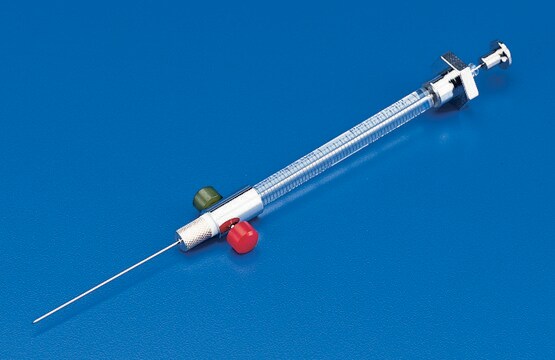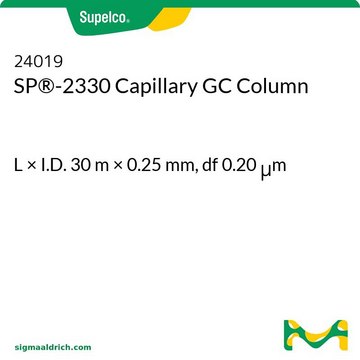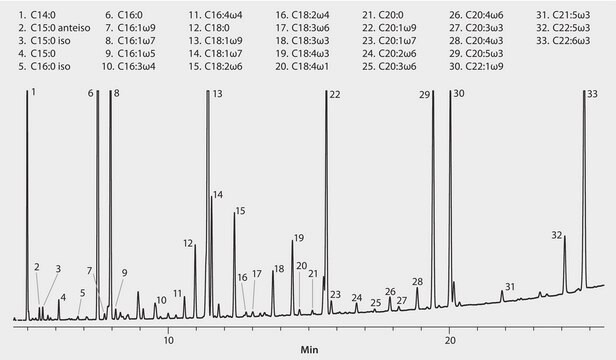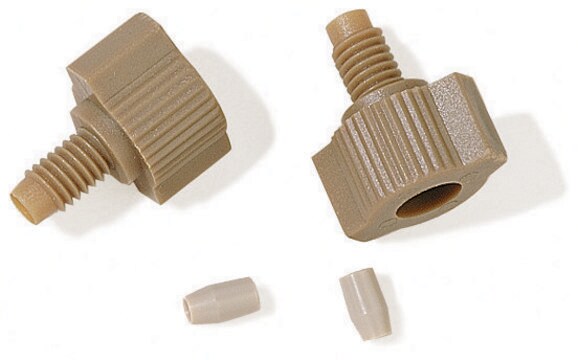24317
SP®-2380 GC-Kapillarsäule
L × I.D. 100 m × 0.25 mm, df 0.20 μm
Anmeldenzur Ansicht organisationsspezifischer und vertraglich vereinbarter Preise
Alle Fotos(1)
About This Item
UNSPSC-Code:
41115710
eCl@ss:
32119290
Empfohlene Produkte
Materialien
fused silica
Agentur
meets requirements for USP G48
Parameter
≤25-275 °C temperature (isothermal or programmed)
Beta-Wert
313
df
0.20 μm
Methode(n)
gas chromatography (GC): suitable
L × ID
100 m × 0.25 mm
Aktive Matrixgruppe
Stabilized; poly(90% biscyanopropyl/10% cyanopropylphenyl siloxane) phase
Anwendung(en)
agriculture
chemicals and industrial polymers
clinical
food and beverages
Säulenart
capillary highly polar
Suchen Sie nach ähnlichen Produkten? Aufrufen Leitfaden zum Produktvergleich
Allgemeine Beschreibung
Capillary GC column is also known as open tubular column. The carrier gas flows through the central aperture and is unrestricted throughout the length of the column.
Anwendung: Eine hochpolare Cyanosiloxan-Säule, die häufig bei der Trennung von geometrischen (cis/trans) Fettsäuremethylester (FAME)-Isomeren als Gruppe verwendet wird. Darüber hinaus eignet sie sich für Anwendungen, bei denen eine hochpolare universell einsetzbare Säule mit guter thermischer Stabilität benötigt wird.
USP-Code: Diese Säule erfüllt die Anforderungen von USP G48.
Phase:
USP-Code: Diese Säule erfüllt die Anforderungen von USP G48.
Phase:
- Stabilisiert
- Poly (90 % Biscyanopropyl/10 % Cyanopropylphenyl-Siloxan)
- Umgebungstemperatur bis 275 °C (isothermal oder programmiert)
Anwendung
- SP®-2380 Capillary Column may be used for determination of fatty acid composition in crude oil in capillary gas chromatography, used along with normal and reverse-phase high-performance liquid chromatography (HPLC) in order to study the content and composition of tocopherols, sterols, and phospholipids in soybean oils derived from genetically-modified soybeans.
- It was used for the identification of fatty acid methyl esters from mammalian samples by fast gas chromatography.
- It was used for determining the hydrogenation level and the level of isomerisation development during the hydrogenation process of edible oils by capillary gas chromatography.
- It was also used in gas chromatography equipped with flame ionization detector (FID) for analysing the cytotoxicity of fatty acids from seed oils containing conjugated linolenic acids (CLN) on mouse tumor and human monocytic leukemia cells.
Sonstige Hinweise
We offer a variety of chromatography accessories including analytical syringes
Rechtliche Hinweise
SP is a registered trademark of Sigma-Aldrich Co. LLC
Hier finden Sie alle aktuellen Versionen:
Besitzen Sie dieses Produkt bereits?
In der Dokumentenbibliothek finden Sie die Dokumentation zu den Produkten, die Sie kürzlich erworben haben.
Kunden haben sich ebenfalls angesehen
Effect of genetic modification on the content and composition of bioactive constituents in soybean oil.
Mounts TL
Journal of the American Oil Chemists' Society, 73 (5), 581-586 (1996)
E M Bondia et al.
Journal of chromatography. B, Biomedical applications, 658(2), 369-374 (1994-08-19)
Total fatty acids in plasma of neonates have been analysed as their methyl esters by gas chromatography. They were separated on a capillary column coated with a SP-2380 stationary phase. As little as 100 microliters of plasma is used for
Fast gas chromatography for the identification of fatty acid methyl esters from mammalian samples.
Stark K and Salem N.
Liposome Technology, 17 (8), 181-181 (2005)
Use of capillary gas chromatography for determining the hydrogenation level of edible oils.
Mateja N and Smidovnik A.
Journal of Chromatography A, 767 (1), 335-339 (1997)
P K Kindel et al.
Carbohydrate research, 199(1), 55-65 (1990-05-15)
The complete acetylation of apiitol required 9 h when acetic anhydride at 120 degrees was used and sodium acetate was the catalyst. Both apiitol pentaacetate and apiitol tetraacetate were detected before acetylation was complete. When the reaction was done in
Unser Team von Wissenschaftlern verfügt über Erfahrung in allen Forschungsbereichen einschließlich Life Science, Materialwissenschaften, chemischer Synthese, Chromatographie, Analytik und vielen mehr..
Setzen Sie sich mit dem technischen Dienst in Verbindung.

